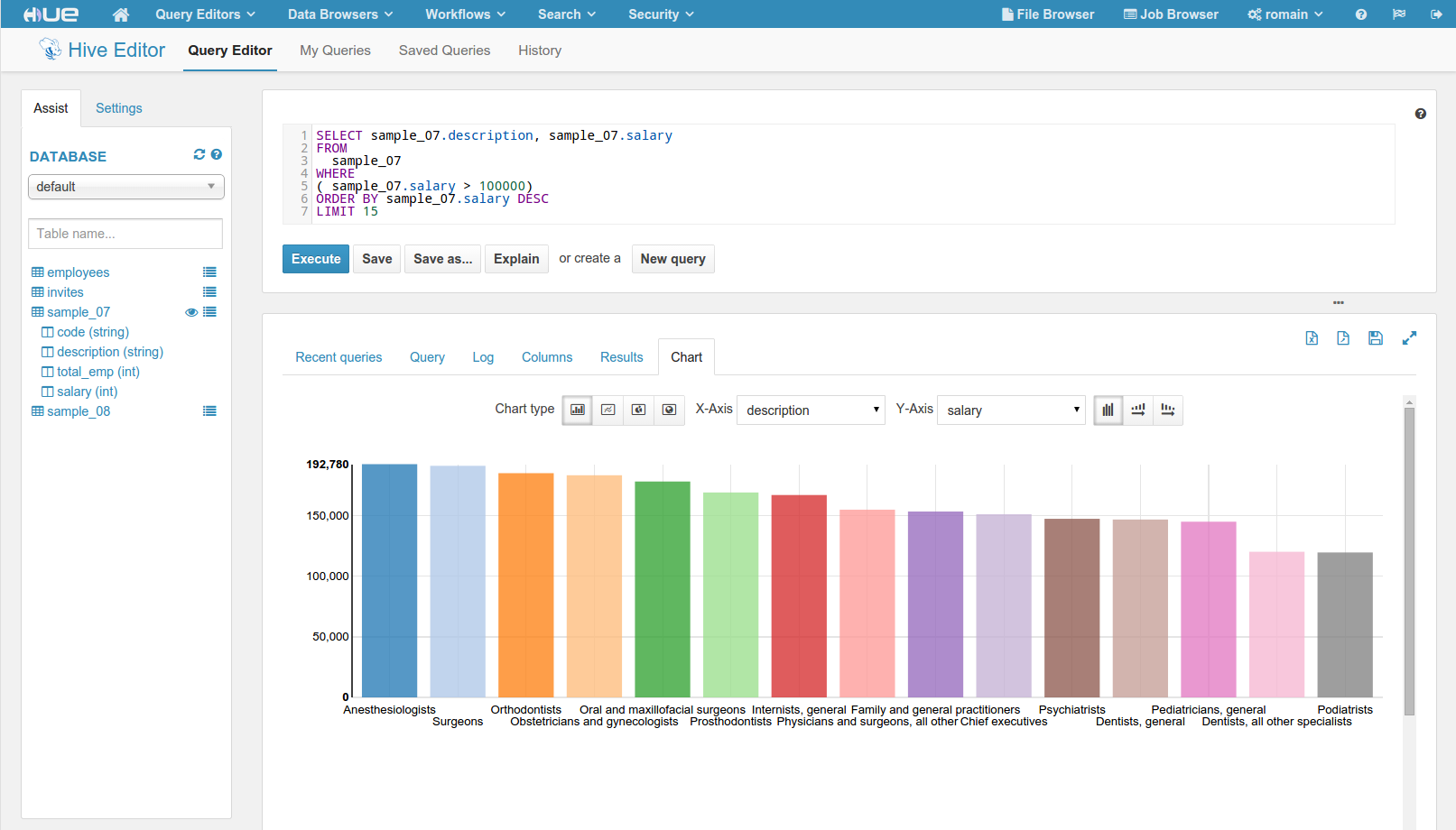Hue is an open source Web interface for analyzing data with Apache Hadoop: gethue.com
It features:
- File Browser for accessing HDFS
- Hive Editor for developing and running Hive queries
- Search App for querying, exploring, visualizing data and dashboards with Solr
- Impala App for executing interactive SQL queries
- Spark Editor and Dashboard
- Pig Editor for submitting Pig scripts
- Oozie Editor and Dashboard for submitting and monitoring workflows, coordinators and bundles
- HBase Browser for visualizing, querying and modifying HBase tables
- Metastore Browser for accessing Hive metadata and HCatalog
- Job Browser for accessing MapReduce jobs (MR1/MR2-YARN)
- Job Designer for creating MapReduce/Streaming/Java jobs
- A Sqoop 2 Editor and Dashboard
- A ZooKeeper Browser and Editor
- A DB Query Editor for MySql, PostGres, Sqlite and Oracle
On top of that, a SDK is available for creating new apps integrated with Hadoop.
More user and developer documentation is available at http://gethue.com.
To build and get the development server running:
$ git clone https://github.com/cloudera/hue.git $ cd hue $ make apps $ build/env/bin/hue runserver
Now Hue should be running on http://localhost:8000 !
The configuration in development mode is desktop/conf/pseudo-distributed.ini.
Note: to start the production server (but lose the automatic reloading after source modification):
$ build/env/bin/supervisor
To run the tests:
Install the mini cluster (only once): $ ./tools/jenkins/jenkins.sh slow Run all the tests: $ build/env/bin/hue test all Or just some parts of the tests, e.g.: $ build/env/bin/hue test specific impala $ build/env/bin/hue test specific impala.tests:TestMockedImpala $ build/env/bin/hue test specific impala.tests:TestMockedImpala.test_basic_flow
You'll need these library development packages and tools installed on your system:
- Ubuntu:
- ant
- gcc
- g++
- libkrb5-dev
- libmysqlclient-dev
- libssl-dev
- libsasl2-dev
- libsasl2-modules-gssapi-mit
- libsqlite3-dev
- libtidy-0.99-0 (for unit tests only)
- libxml2-dev
- libxslt-dev
- make
- mvn (from
mavenpackage or maven3 tarball)- openldap-dev / libldap2-dev
- python-dev
- python-setuptools
- libgmp3-dev
- CentOS/RHEL:
- ant
- asciidoc
- cyrus-sasl-devel
- cyrus-sasl-gssapi
- gcc
- gcc-c++
- krb5-devel
- libtidy (for unit tests only)
- libxml2-devel
- libxslt-devel
- make
- mvn (from
mavenpackage or maven3 tarball)- mysql
- mysql-devel
- openldap-devel
- python-devel
- sqlite-devel
- openssl-devel (for version 7+)
- gmp-devel
- MacOS:
- Xcode command line tools
- Oracle's JDK 1.7+
- maven (Homebrew)
- mysql (Homebrew)
- gmp (Homebrew)
The Hue "framework" is in desktop. /core/ contains the Web components and
desktop/libs/ the API for talking to Hadoop.
The installable apps live in apps/. Please place third-party dependencies in the app's ext-py/
directory.
The typical directory structure for inside an application includes:
- src/
- for Python/Django code
- models.py urls.py views.py forms.py settings.py
- conf/
- for configuration (
.ini) files to be installed- static/
- for static HTML/js resources and help doc
- templates/
- for data to be put through a template engine
- locales/
- for localizations in multiple languages
For the URLs within your application, you should make your own urls.py
which will be automatically rooted at /yourappname/ in the global
namespace. See apps/about/src/about/urls.py for an example.
Hue would not be possible without:
- Python 2.6.5 - 2.7
- Django 1.6 (https://docs.djangoproject.com/en/1.6/)
- Knockout.js (http://knockoutjs.com/)
- jQuery (http://jquery.com/)
- Bootstrap (http://getbootstrap.com/)
- User group: http://groups.google.com/a/cloudera.org/group/hue-user
- Jira: https://issues.cloudera.org/browse/HUE
- Reviews: https://review.cloudera.org/dashboard/?view=to-group&group=hue (repo 'hue-rw')
Apache License, Version 2.0 http://www.apache.org/licenses/LICENSE-2.0

